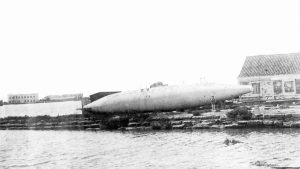 ©ElEspañol
©ElEspañol
Isaac Peral es considerado el inventor del submarino porque revolucionó el sector de la navegación militar realizando cambios que permitía que el submarino se propulsara eléctricamente y que, además incorporaba un torpedero bajo el mar.
Debido a su carrera militar en la Marina, la idea de Isaac Peral era solucionar el problema de la defensa nacional a través de máquinas modernas, intentando crear así, el arma de guerra perfecta.
El 20 de septiembre de 1844, su idea fue trasladada al papel sobre unas cuartillas firmadas y tituladas “Proyecto de Torpedo Submarino”. En 1885, España fue amenazada por los alemanes en las Islas Carolinas, donde llegó el acorazado “Iltis”. A raíz de este fenómeno, Peral decidió hacer público su diseño, obteniendo un apoyo total. Finalmente, en 1888, el invento fue botado en el arsenal de La Carrasca (Cádiz) con gran expectación.
La nave consistía en un casco de acero, de 22 metros de eslora, 2,87 metros de manga en su Cuaderna Maestra. Presentaba una torreta en el centro, donde se ubicaban las escotillas de entrada. El interior se encontraba pintado de blanco y el exterior presentaba un color gris. Incorporó en él, además, un periscopio moderno y numerosos detalles con los que Isaac fue resolviendo algunos problemas como la provisión de oxígeno o el empañado de los cristales. El pasillo que recorría el submarino de proa a popa estaba iluminado por luz eléctrica de bombillas. Tanto en las paredes como en el techo había cajetines ocres de madera que cubrían las conducciones eléctricas. El suelo se encontraba forrado de una alfombra de forma que actuaba como aislante de la electricidad de la nave. El submarino estaba planteado para alcanzar una velocidad general de 8 nudos y 3 nudos en inmersión. El espacio contaba con un total de 12 tripulantes.
Actualmente, se encuentra preservado como buque museo en Cartagena (Murcia), ciudad natal del inventor.
Isaac Peral sumó así, un argumento al nombre de “Edad de Plata” con que se reconoció el siglo XIX a las ciencias españolas.
RTVE lanzó el 8 de octubre de 2022 un documental disponible aquí.
__
ISAAC PERAL’S SUBMARINE
Isaac Peral is considered the inventor of the submarine because he revolutionized the military navigation sector by making changes that allowed the submarine to be electrically propelled and also incorporated a torpedo boat under the sea.
Due to his military career in the Navy, Isaac Peral’s idea was to solve the problem of national defense through modern machines, trying to create the perfect weapon of war.
On September 20, 1844, his idea was transferred to paper on a signed sheet of paper entitled “Submarine Torpedo Project”. In 1885, Spain was threatened by the Germans in the Caroline Islands, where the battleship “Iltis” arrived. As a result of this phenomenon, Peral decided to make his design public, obtaining full support. Finally, in 1888, the invention was launched in the arsenal of La Carrasca (Cadiz) with great expectation.
The ship consisted of a steel hull, 22 meters long, 2.87 meters beam in its master quarterdeck. It had a turret in the center, where the entrance hatches were located. The interior was painted white and the exterior was gray. It also incorporated a modern periscope and numerous details with which Isaac was solving some problems such as the supply of oxygen or the fogging of the crystals. The corridor that ran through the submarine from bow to stern was illuminated by electric light bulbs. The walls and ceiling were lined with ocher wooden boxes covering the electrical conduits. The floor was lined with a carpet that acted as an insulator of the ship’s electricity. The submarine was designed to reach an overall speed of 8 knots and 3 knots when submerged. The space had a total of 12 crew members.
Nowadays, it is preserved as a museum ship in Cartagena (Murcia), the inventor’s hometown.
Isaac Peral thus added an argument to the name “Silver Age” with which the Spanish sciences were recognized in the 19th century.
__

